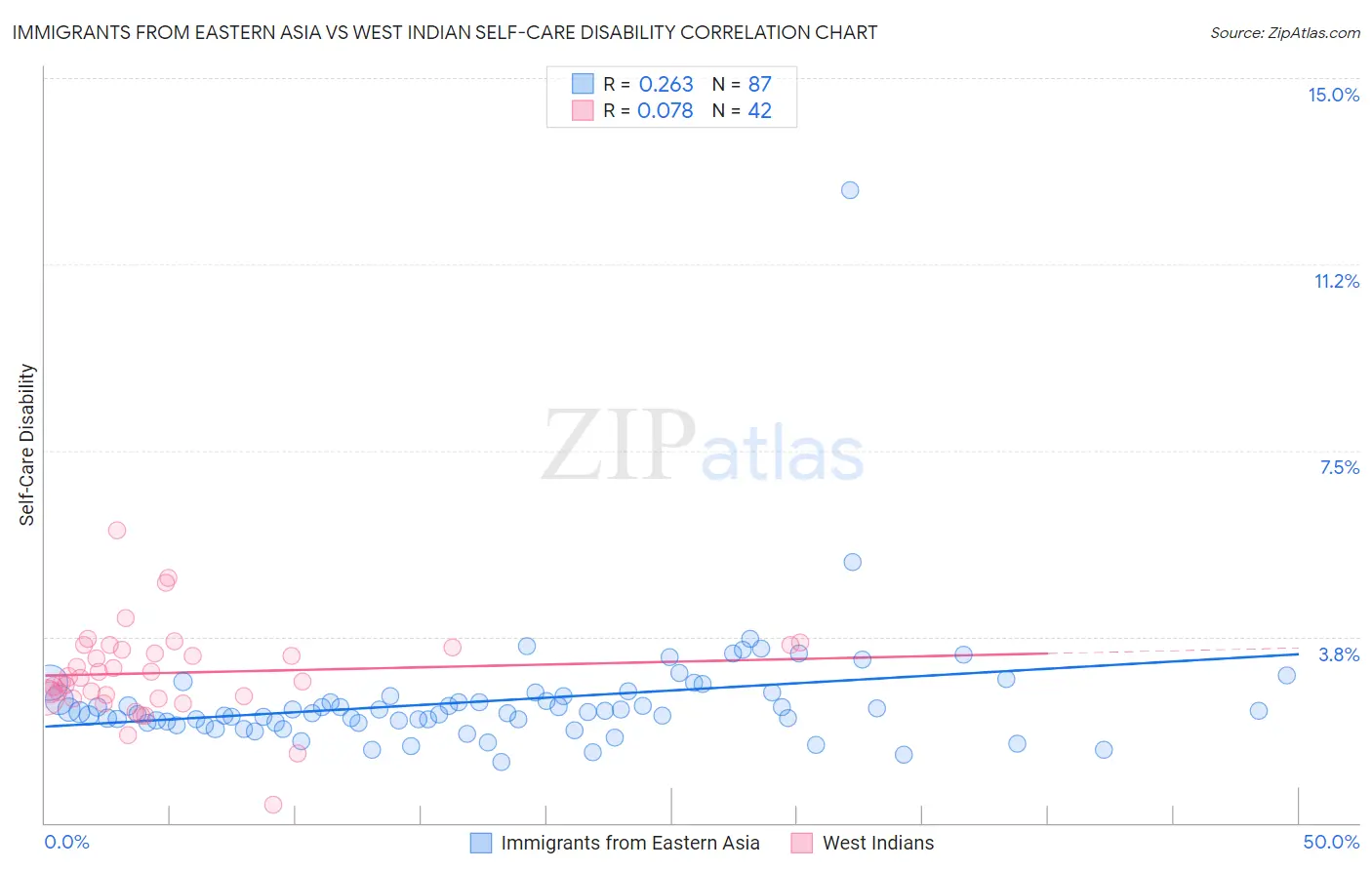Immigrants from Eastern Asia vs West Indian Self-Care Disability
COMPARE
Immigrants from Eastern Asia
West Indian
Self-Care Disability
Self-Care Disability Comparison
Immigrants from Eastern Asia
West Indians
2.3%
SELF-CARE DISABILITY
99.6/ 100
METRIC RATING
56th/ 347
METRIC RANK
2.8%
SELF-CARE DISABILITY
0.0/ 100
METRIC RATING
297th/ 347
METRIC RANK
Immigrants from Eastern Asia vs West Indian Self-Care Disability Correlation Chart
The statistical analysis conducted on geographies consisting of 498,784,533 people shows a weak positive correlation between the proportion of Immigrants from Eastern Asia and percentage of population with self-care disability in the United States with a correlation coefficient (R) of 0.263 and weighted average of 2.3%. Similarly, the statistical analysis conducted on geographies consisting of 253,805,677 people shows a slight positive correlation between the proportion of West Indians and percentage of population with self-care disability in the United States with a correlation coefficient (R) of 0.078 and weighted average of 2.8%, a difference of 19.8%.

Self-Care Disability Correlation Summary
| Measurement | Immigrants from Eastern Asia | West Indian |
| Minimum | 1.2% | 0.38% |
| Maximum | 12.8% | 5.9% |
| Range | 11.5% | 5.5% |
| Mean | 2.5% | 3.0% |
| Median | 2.2% | 2.9% |
| Interquartile 25% (IQ1) | 2.0% | 2.5% |
| Interquartile 75% (IQ3) | 2.6% | 3.5% |
| Interquartile Range (IQR) | 0.53% | 1.00% |
| Standard Deviation (Sample) | 1.3% | 0.93% |
| Standard Deviation (Population) | 1.3% | 0.92% |
Similar Demographics by Self-Care Disability
Demographics Similar to Immigrants from Eastern Asia by Self-Care Disability
In terms of self-care disability, the demographic groups most similar to Immigrants from Eastern Asia are Immigrants from Belgium (2.3%, a difference of 0.010%), Immigrants from France (2.3%, a difference of 0.040%), Immigrants from Cameroon (2.3%, a difference of 0.080%), Argentinean (2.3%, a difference of 0.10%), and Australian (2.3%, a difference of 0.15%).
| Demographics | Rating | Rank | Self-Care Disability |
| Latvians | 99.7 /100 | #49 | Exceptional 2.3% |
| Immigrants | Brazil | 99.7 /100 | #50 | Exceptional 2.3% |
| Kenyans | 99.7 /100 | #51 | Exceptional 2.3% |
| Immigrants | Serbia | 99.6 /100 | #52 | Exceptional 2.3% |
| Australians | 99.6 /100 | #53 | Exceptional 2.3% |
| Argentineans | 99.6 /100 | #54 | Exceptional 2.3% |
| Immigrants | France | 99.6 /100 | #55 | Exceptional 2.3% |
| Immigrants | Eastern Asia | 99.6 /100 | #56 | Exceptional 2.3% |
| Immigrants | Belgium | 99.6 /100 | #57 | Exceptional 2.3% |
| Immigrants | Cameroon | 99.6 /100 | #58 | Exceptional 2.3% |
| New Zealanders | 99.5 /100 | #59 | Exceptional 2.3% |
| Immigrants | Japan | 99.5 /100 | #60 | Exceptional 2.3% |
| Palestinians | 99.4 /100 | #61 | Exceptional 2.3% |
| Egyptians | 99.4 /100 | #62 | Exceptional 2.3% |
| Mongolians | 99.3 /100 | #63 | Exceptional 2.3% |
Demographics Similar to West Indians by Self-Care Disability
In terms of self-care disability, the demographic groups most similar to West Indians are Immigrants from Portugal (2.8%, a difference of 0.090%), American (2.8%, a difference of 0.12%), Immigrants from Guyana (2.8%, a difference of 0.21%), Barbadian (2.7%, a difference of 0.51%), and Central American Indian (2.7%, a difference of 0.66%).
| Demographics | Rating | Rank | Self-Care Disability |
| Cubans | 0.0 /100 | #290 | Tragic 2.7% |
| Guyanese | 0.0 /100 | #291 | Tragic 2.7% |
| Central American Indians | 0.0 /100 | #292 | Tragic 2.7% |
| Belizeans | 0.0 /100 | #293 | Tragic 2.7% |
| Blackfeet | 0.0 /100 | #294 | Tragic 2.7% |
| Barbadians | 0.0 /100 | #295 | Tragic 2.7% |
| Immigrants | Portugal | 0.0 /100 | #296 | Tragic 2.8% |
| West Indians | 0.0 /100 | #297 | Tragic 2.8% |
| Americans | 0.0 /100 | #298 | Tragic 2.8% |
| Immigrants | Guyana | 0.0 /100 | #299 | Tragic 2.8% |
| Immigrants | Fiji | 0.0 /100 | #300 | Tragic 2.8% |
| Pima | 0.0 /100 | #301 | Tragic 2.8% |
| Immigrants | St. Vincent and the Grenadines | 0.0 /100 | #302 | Tragic 2.8% |
| Immigrants | Belize | 0.0 /100 | #303 | Tragic 2.8% |
| Cree | 0.0 /100 | #304 | Tragic 2.8% |